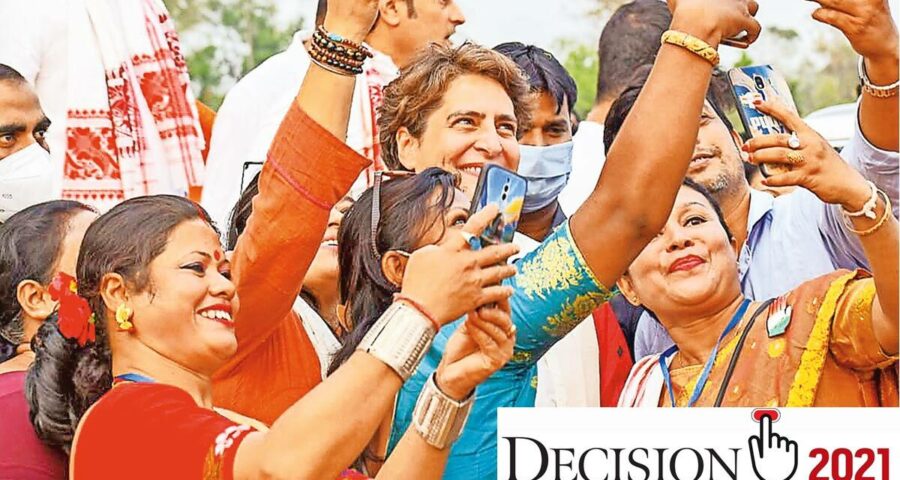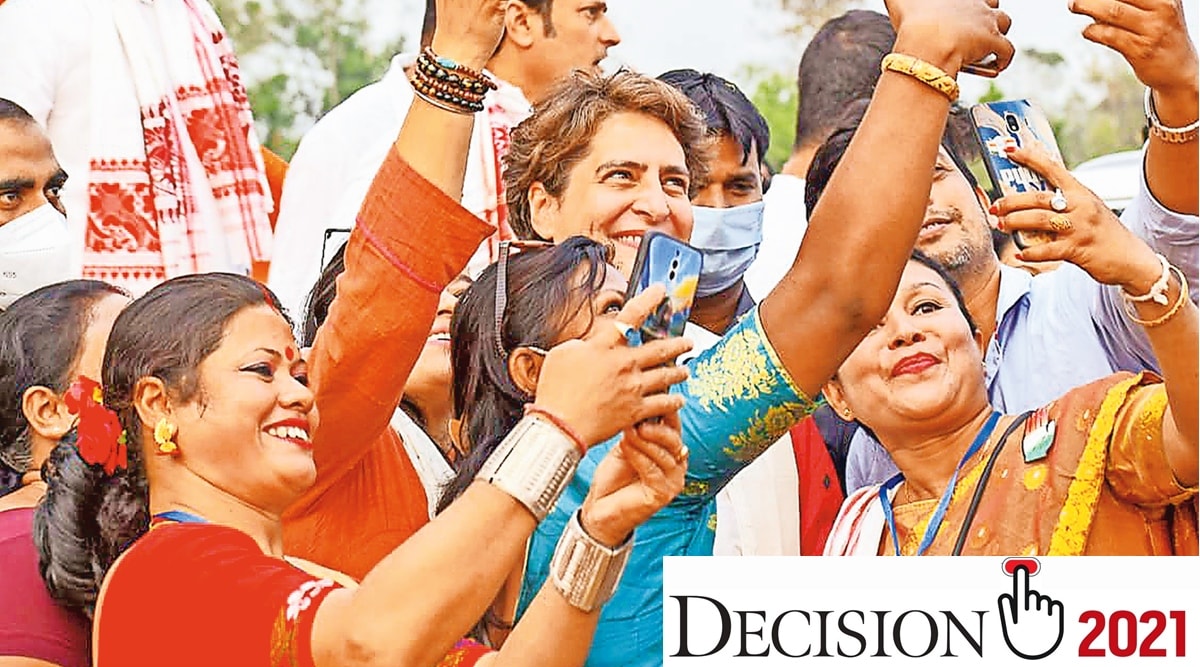Upper Assam appears to have moved on, to issues of govt schemes and price rise; popularity of AJP leader Lurinjyoti Gogoi may not translate into votes.
It is the first sunny day in a week, but it does little to lift Pardeep Daimari’s mood. As a cavalcade of state government cars passes by his grocery shop in Kachari Pathar village in Upper Assam’s Dibrugarh district, Daimari shrugs dispassionately: “It’s all the same.”
In 2016, Pradeep had voted for “change” (the BJP), but days to go for polling, he is on the fence. “Look at the road near my home,” he says. His disillusionment is also on account of the Covid-19 lockdown, that killed a taxi business before it could even start and left him with a loan he for a Santro. The family of three, that didn’t benefit from any of the BJP government’s schemes, survives on this shop now.
Upper Assam, which votes on March 27, lies at the heart of the state’s ethnic sub-nationalism, seeing the most vociferous anti-CAA protests. Pradeep and wife Rupali — who belong to the larger Sonowal Kachari community — joined the agitation in Duliajan town nearby.
However, for the Daimary couple, the CAA now seems a distant, pre-pandemic memory — like across the ‘Axomiya’ heartland. It is yet to be seen if the BJP’s Bengal promise on the Act causes some ripples.
Waiting to pick up his son from cricket practice at Sivasagar — once the seat of the Ahom empire — Niranjan Gogoi says the CAA won’t be a factor in polling. “It really doesn’t affect ordinary, middle-class folk like me,” he says. “Politics like this is beyond us.”
While the Congress has made revocation of the CAA its central promise, party workers on the ground admit it is not moving voters. “We probably did not take advantage of it (the CAA issue) when we had the chance to do so,” says a Congress worker in Amguri constituency (Sivasagar district).
In Mariani constituency, which falls under Johar district, Atul Gogoi, an ex-Congress worker, says there is only anti-incumbent angst against the BJP. “If they fail, it will be because of issues like price rise.”
On Sunday, soon after the BJP release its Bengal manifesto with the CAA promise, all the major Congress leaders in Assam questioned if the party would also implement the Act in Assam.
The BJP, that is counting on time healing the CAA wound, has made ‘development’ its main plank — or, at least, its slew of populist cash schemes.
Ankur Hazarika, a teacher at Lower Primary school in Dergaon constituency (Golaghat district), says voters are unlikely to be affected unless an issue “personally impacts you”. “It is obvious we (the Assamese) do not like foreigners — Hindus or Muslims. But then again, we voted for the BJP knowing it’s a Hindu party.”
This indifference means the two new regionalist political parties — Assam Jatiya Parishad (AJP) and Akhil Gogoi’s Raijor Dal (RD) — born out of the CAA agitation may be a non-starter.
Sabita Konwar, a 43-year-old housewife, from Kopuhua Gaon in Duliajan, has come for an AJP rally. AJP president Lurinjyoti Gogoi is the candidate from Duliajan. Konwar says she will vote for him as the BJP will “privatise everything, bring in foreigners and endanger the Assamese jaati”. Yet, looking around at the field, where only 70-odd people have showed up, Konwar knows his chances are quite bleak.
Lurinjyoti, who is contesting from Duliajan as well as Naharkatiya constituencies, arrives for the meeting almost two hours behind schedule. In his speech, the 39-year-old talks about “the need to protect ourselves, our identity, our land, our community”, and says “only a jatiyotabadi (Assamese nationalist) party” can do this.
Lurinjyoti, a former All Assam Students’ Union (AASU) general secretary, came into his own during the December 2019 protests, his fiery speeches and enthusiasm tapping into the people’s anger. One of his rallies in Dibrugarh reportedly drew a crowd of a lakh.
Speaking to The Indian Express, Lurinjyoti says he needed to join politics to make a difference. “As an activist, I may shout slogans on the street but… a law can still be passed overnight in Delhi.”
These days, Lurinjyoti is holding at least 15 meetings a day — from 8 am to 11 pm. Realising the dwindling traction of the CAA, he urges people not to be taken in by government schemes. “You may be getting free grains, but the money that you save you are spending on inflated costs of potatoes and onions,” he tells the crowd in Kopohua.
Lurinjyoti claims he is not stressed about the tough fight ahead. In Naharkatiya, he is up against Taranga Gogoi, a young protege of the BJP’s Himanta Biswa Sarma, and in Duliajan, incumbent BJP MLA Terash Gowalla.
In the run-up to the polls, the AJP announced an alliance with the Raijor Dol. Lurinjyoti says he chose the hard path. “If we had to do opportunistic politics, we would have allied with the Congress. A true Assamese party cannot ally with the big players, otherwise what is the point in our ideology?… Right now, we need to establish an ideology. Only after you lay the foundation, can you build a house.”
Hazarika, the teacher at Dergaon, says the people have heard such promises before. From the Asom Gana Parishad (AGP), the regionalist party formed post the Assam Agitation, which is now in alliance with the BJP. “Look at what happened to the party made from our own blood. What did they do? Nothing. At least with the BJP, the overall medical facilities, roads and education system are better.”
Source: Read Full Article


